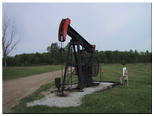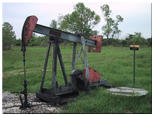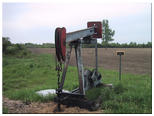


We then drove down the road to the towns of "Oil City" and "Oil Springs". The original oil rush was in the relatively small oil field (only a couple of square kilometres) south of Oil Springs. There are hundreds of holes in the ground here, a lot of them still producing but also a lot of shut-down older stuff. The electric pump rig in the first picture was the smallest electric pump we saw. It was not running. In the pictures following, the crumbling remains of a jerker system installation. In the leaning shack is the complete power plant, with nothing missing. It looks as though it has been converted from steam to internal combustion to electric power over the years. Notice the modern electric meter next to the knife switch and knob-and-tube wiring.
I love it how this place, despite being 20m from the road and unprotected, is completely unvandalized after being out of use for years.
Behind the barn across the road, there is a bunch of vintage oil equipment including an old and a very old drilling rig, and an intact jerker pump. There is also a "Keep Out" sign here so we don't stay long.
Further down the road, we discover the working oil field belonging to Charles Fairbank, a grandson or maybe great-grandson of one of the oil pioneers here. The first thing we see is a modern electric pump, but after that it's nothing but vintage jerker system stuff.
Standing in the field here and hearing the gentle creaking of vintage oil pumps all around in the early morning quiet, is something that just has to be experienced.
I invade the oil field enough to get between the rails of the main jerker line and snap a picture. But then someone I can't see shouts for me to get out of there. Not wanting trouble, I do so immediately.
Across the road, a differerent operator is using steel cable jerker technology - same principle of sharing a central power plant among a bunch of low-yield wells, but here in the style they used in the Pennsylvania oil fields (probably imported from there).
Meanwhile the oil museum is open so we go there. The museum is very good, with lots of history and artifacts. I like the working model steam engines (you can run them with compressed air). In the basement there is "generic museum stuff" (1800s but not oil related) such as the all-wood bicycle.
They have a demonstration jerker system (with dummy wells) here. When we arrive it is running but later it is not. I look in the power house and find that the belt has snapped.
This museum isn't just anywhere. It is on the site of the very first oil well in North America. Right by here is a disused railway station. Surely that was moved here? Apparently not, as you can still see the raised ground where the rail was. The stereotypical looking oil derrick is genuine too, complete with a steam engine pumping arrangement.
Somewhat out of place in all this vintage museum stuff is this building containing a giant compressor left over from a more modern era.